“Sam (Adams) has directed (City Traffic Engineer) Rob Burchfield to indentify opportunities for a “high visibility” cycle track to be rolled out in Sam’s first 100 days as mayor.”
— Sam Adams’ chief of staff Tom Miller, in an email to Metro Councilor Rex Burkholder
There’s no denying that 2009 is shaping up to be the Year of the Cycle Track in Portland.
PDOT already has one in the books for NE Cully Blvd., they’re working closely with streetcar planners to put one adjacent to the new line in the Lloyd District on NE 7th Ave., and planners, advocates, and other local bike insiders (including our next Mayor and his chief of staff) are all singing the cycle track’s praises after seeing them in action in cities like Amsterdam and Copenhagen.
But you can’t simply copy-paste the idea from those world-class bike cities where 30-40% of all trips are made by bike and where official policies aggressively prioritize bike traffic over motor vehicle traffic.
That’s why true, European-style cycle tracks — built on a separate grade from car and pedestrian traffic — are challenging to build in Portland. PDOT engineers were able to pull a Copenhagen-esque facility off on NE Cully because they had a clean slate to work with (it’s a complete road rebuild) and the land-use in that area is residential.
The challenge will be how to build a cycle track in an urban context like in downtown Portland. With short block-faces and numerous driveways, PDOT has to move much more cautiously. That being said, there is more likelihood that Portland’s future downtown cycle-tracks will be a watered down, “American-style” version.
One location where we might see the first attempt a physically separated bikeway/cycle track treatment in downtown Portland could be SW Broadway. That street is a major artery in the bikeway network as it serves traffic coming off the Broadway Bridge and it runs into the heart of downtown.
Broadway is also a familiar nemesis to both riders and PDOT engineers. Many who bike on Broadway feel the existing standard bike lane is more dangerous to ride in than simply taking the lane. However, most riders — especially less experienced ones — still use the bike lane despite its drawbacks.
From PDOT’s perspective, they know SW Broadway is a hot-spot for crash activity and that it’s one of the most unpopular (yet busy) bikeways in the city. They’ve made a stop-gap attempt to make it better by writing “Hotel Zone Warning” in the bike lane in order to warn riders that valets, cabbies, and tourists might not respect their travel lane.
Rex Burkholder, founder of the BTA, now a Metro Councilor, and Chair of Metro’s powerful Joint Policy Advisory Committee on Transportation (JPACT) is one of the many local transportation heavy-hitters (including PDOT’s head traffic engineer) who recently experienced cycle tracks first-hand in Europe.
“Time for bold action, not retrenchment.”
— from a letter by Rex Burkholder to Mayor-elect Sam Adams
Fresh off a trip to Amsterdam and Copenhagen as part of a fact-finding mission for Metro’s Blue Ribbon Committee for Trails, Burkholder wrote Portland’s transportation commissioner and Mayor-elect Sam Adams a letter (dated 11/24) on what things Portland might do in the near-term to emulate those model biking cities.
In that letter (which Burkholder has given me permission to excerpt from), Burkholder told Adams that this is a “Time for bold action, not retrenchment” and he wrote specifically about cycle tracks:
The time is ripe for these innovations in Portland: Current bike lanes are just too narrow for the amount of bike traffic on many feeders into downtown so that we get congestion and conflict among cyclists.
I think they have tremendous potential to help more people feel safe riding, are relatively easy and inexpensive to install and can increase the capacity of our main line cycle routes.
One of the locations suggested by Burkholder for the cycle track treatment was SW Broadway.
Adams’ chief of staff Tom Miller replied via email to Burkholder. I obtained a copy of that email and in it, Miller wrote:
We certainly agree that Portland can and should continue innovating (as an American city) to provide safer, more effective facilities for would-be bicyclists. Many, if not all, of your specific ideas are good ones.
Miller than listed several “important strides” PDOT is making to “bring Dutch and Danish accomplishments to Portland.” One of those is to identify opportunities for a “high visibility” cycle track to be “rolled out in Sam’s first 100 days as mayor.” Miller went on to write that, “Like you, I think SW and/or NE Broadway could be ripe for an improved street treatment.”
A few weeks ago, New York City-based livable streets blog Streetsblog shared a story about the success of their own “American-style” separated bike lane on Grand Street in downtown New York City.
That facility (shown below) struck me as being very similar to the road configuration that currently exists on SW Broadway. Compare this view of Grand Street in NYC…
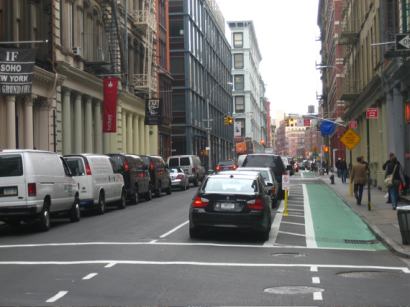
… with this view of SW Broadway in Portland:
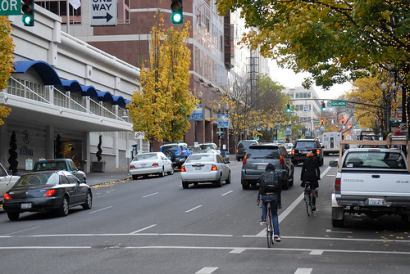
It seems like riding conditions on SW Broadway could be vastly improved with a Grand Ave-style treatment and it would not require any major engineering or large budget to make it happen. Also, with momentum from respected advisors and their own, first-hand experience with these types of facilities, it seems PDOT, with Mayor-elect Adams at the helm, is poised to make it happen.
It will be very interesting to observe how PDOT deals with increasing pressure to build innovative bike facilities. The Copenhagen Effect will no doubt be a powerful force in the coming years.

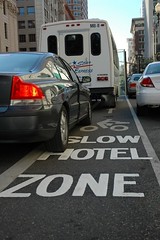

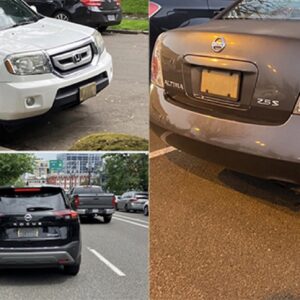
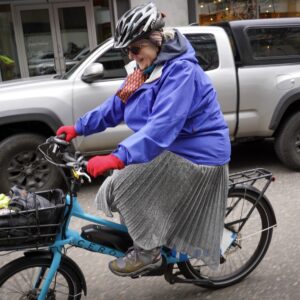
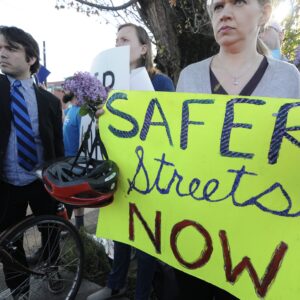
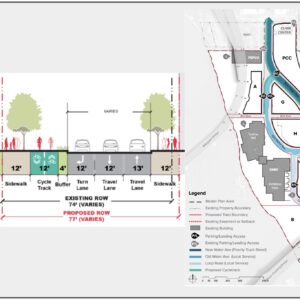
Thanks for reading.
BikePortland has served this community with independent community journalism since 2005. We rely on subscriptions from readers like you to survive. Your financial support is vital in keeping this valuable resource alive and well.
Please subscribe today to strengthen and expand our work.
If they put something like this in on Broadway how would they deal with cyclists looking to make a left turn?
i think there are a lot of ways left turns can be handled. one of them that is common in Copenhagen (from what I’ve read) is the two-step or “jug-handle” left turn. This is where you would come to an intersection and then position yourself into the traffic of the direction you intend to go.
I’ve seen many people do this at SE 7th and Hawthorne, where, instead of merge the three lanes of Hawthorne traffic, folks simply cross the intersection and then position themselves in the bike lane of SE 7th, wait for the light, and then proceed.
I’ve started using that method around town and it works well.
here’s another photo of the Grand Ave example I refer to in the story. It shows how the striping is done at the intersection.
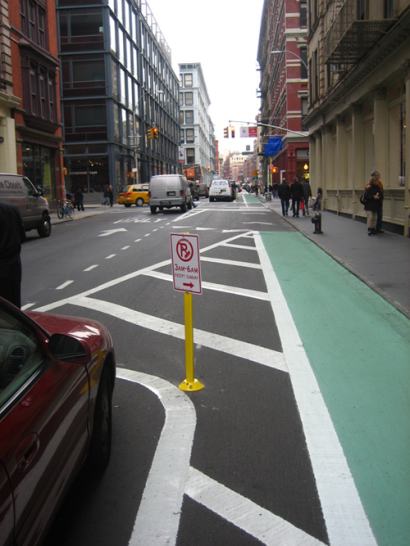
Why not put a dedicated cycle street one block west of Broadway along the park blocks. This could be a pedestrian/cycle only zone complete with kiosks, food carts, recreation areas. This gets us totally away form the crazyness on Broadway.
Portland –
How many cyclists need by crushed to death by right turning trucks?
How is this going to make anything better in that regard?
There are many reasons why sidepaths in other countries work better than they would here.
#1. NO right turn on red
#2. Bike and car collide……driver is ALWAYS at fault.
#3. Intersections built at 90 degrees. There are not sweeping curves like we have. Cars have to go much slower to turn right over there.
This will be just like riding on the sidewalk and every cyclists knows why that is dangerous.
I dont get this. Help me understand.
I looked at the NYC model and I like it.
It takes into account the “right hook” by mixing cars and bikes at the intersections.
Portland refuses to do that with its bike lanes and mandates that bikes stay in the crunch zone all the way to the light.
Is this going to change with these cycle tracks in Portland or will they follow the NYC more common sense model?
Tim you forgot #4 – separate signal phase for cyclists.
IMO, this is just more nonsense. Where oh where are the sharrows? Ten years later and still waiting….
Tim,
Yes get rid of the bike lane all the way to the intersection. Stop enticing cyclists into a dangerous situation, even though it is legal.
I have ridden several of Europe’s cycleways and am not sold on them as a general infrastructure component within the city … though I do see some use for them when they run adjunct to a high-speed intra-city motorway.
I especially did not like the raised cyclepaths … seems like a diverting fall just waiting to catch you … nor their tendency to cross streets mid-block. When they are connected to the street, like bike lanes, they detract from proper navigation of intersections.
I think one of the principal reasons all this segregated infrastructure appears to be a good think in Europe is the prevailing acceptance of the bicycle as a vehicle on the roadway. Even then, in cities such as Amsterdam or Copenhagen, they’ve had to over-engineer things like traffic signals with segregated bike only and motor vehicle only phases.
Personally I do not see why we need to expend tens of millions of dollars on a separate bicycle infrastructure – which frequently winds-up designated multi-use to justify the expenditure – when we have a perfectly appropriate network {streets and roads} that take us where we need/want to go.
If we put a fraction of the cost of a separate infrastructure into education and enforcement – for drivers of all types of vehicles – and simply made it clear that the road is to be shared … period. … we would all be better for it.
In many places where I have worked, visited, and ridden in Europe, you can remove the segregated infrastructure {or go to a smaller community where it does not exist} and things would still continue to flow along much as they do now … it’s the culture, and not the infrastructure, that makes the difference.
Is it really “cultural”? The bikey Euro cities didn’t achieve their high percentage of bike usage until the infrastructure was built following the 1970s oil shocks. Now, millions of Europeans seem to be able to do amazing things like make left turns and ride on raised paths every day without disaster striking. Neither posed a problem for me while biking in Holland. Are Portlanders less capable of adapting?
I heard the city traffic engineer talk about the Copenhagen research and it gives me a lot of confidence that he and the city planners really know what they’re doing here, and will adapt these tried and true practices to our particular environment. For example, cycle tracks should augment , not replace, the network Portland’s already built, so probably they’ll be much less extensive than Copenhagen et al. And I think Portland drivers and bike riders will also adapt. Education will be a big part of all this.
Good points about the other factors beyond infrastructure.
Should we consider adopting policies like no right turn on red on dangerous streets (which pose great danger to pedestrians as well to bike riders) and presuming (a rebuttable presumption, of course) driver liability in encounters with bikes and pedestrians? Mayor elect Adams has emphasized safety, and this is a safety issue as much as a mobility issue.
Given the history of US car-centric development (especially among traffic engineers) I feel grateful that we have visionary leaders and staffers who are willing to learn from others’ experience while still thinking differently (from failed American models) about urban mobility. We’re living in a new reality now, with climate change etc. and it’s time our city adapted.
It’s gonna be touchy in this transition period, but history shows that the new infrastructure will vastly increase the number of riders, and when that happens, the auto-centric culture will change, as it did in Europe. With so many bikes on the road, drivers will start assuming they’re there and pay much more attention to possible encounters with them. And more drivers will also be bike riders, which will make them (us) more aware of potential bike encounters.
With the President Obama (wow, it feels good to say that) ready to invest in long overdue infrastructure overhauls, and Portland poised to lead the way, this could be an exciting moment. Ultimately the investment will pay off: less gridlock, less spending on gas, lower carbon footprint, more mobility and choices, a more livable city.
The problem I would anticipate with putting a bike lane to the right of parked cars involves side traffic. Drivers wanting to enter the main road from the right will tend not to stop until they have encroached completely over the bike lane in order to see past the parked cars on the street they want to enter. All intersections along such a roadway would have to be signalized (no two-way stops) to make them even marginally safe–and definitely no turn on red.
…And regarding culture/awareness vs. infrastructure, it may be we have a catch-22 on our hands where more riders means more driver awareness means less need for special infrastructure, but less special infrastructure (initially) means fewer riders means less driver awareness means more need for special infrastructure to encourage more riders…
As someone who has lived in Stockholm and explored big cities throughout Europe by bicycle, I noticed that inner-city ‘cykel’ tracks were often slow and nearly impossible to pass others on. I feel like the way they designed the infrastructure was with old (read: slower) coaster break bikes in mind. With American’s love of lighter and faster bikes for commuting and running errands (only now do people seem to be riding bikes built for functional city living),I wonder if the bicycle tracks as designed in Europe are appropriate in downtown areas here in the USA. I had a road bike with me and found that between trying to pass people and …!!!! there being bricks surfaces and cuts in the pavement that would almost eat my tires… these tracks were not built for skinny tired bikes. I stopped riding on the bicycle tracks through downtown unless I planned on riding at a slow speed. Another annoyance was that a certain distance before the intersection the track would put you back in the street, you’d cross and then join the track again. This would repeat at every block that there was an intersection. That much zig-zagging can really wear on you. A cool thing was that in some neighborhoods they blocked some intersections to reduce through-traffic and allow bicyclists to proceed without stopping.
Having said that, the last part of my commute from the city center to a close town nearby happened via a bicycle track that followed along the highway. The track was wide and had a bicycle signal at intersections. In the winter they regularly plowed the path of snow (wish I had a cyclo-cross with me, I took the subway when it snowed).
With segregated bike tracks next to roadways I wonder if the instance of automobile drivers feeling the need to tell you to get out of the road will increase if you choose to use the road because of conditions on the track, or your speed. Just throwing that out there.
bretto,
The “build it and they came” story for cycling infrastructure in Europe is not reflected statistically to the degree that is assumed … i.e. the myth is larger than the numbers.
In many countries you will find that bicycle usage was higher(est) in the late 1940s, early 1950s, following the War.
The mantra of the personal automobile did erode the bike share during the 50s-70s, but not as completely as in NA where we still view bicycles as a child’s toy. Building, rather than cannibalizing, public transit is another factor.
It is true that the infrastructure build starting in the {late 60s} 70s & 80s were partially in the build-it-they will come, but there were other social policy motivations that were at play.
Recent studies in those reviewed cycling meccas of Denmark and Holland have raised questions about segregated infrastructure and the fact that they have not produced the anticipated results, particularly in incident reduction. Some of this has lead to the elaborate multiphase traffic signals.
Some separate infrastructure may be a necessary thing, but segregation is seldom the answer to the mixing of different peoples. The introduction of separate bicycle facilities in NA was done with the benefit of motorists, not cyclists, in mind.
Now .. if we really wanted a primarily bicycle dominated infrastructure without spending additional millions our governments could simply discourage motorists by eliminating petroleum subsidies and raising prices at the pumps … suddenly you would have 6-lane cyclepaths 😉
Ryan — at the presentation last week, they mentioned that Copenhagen had twice increased the width of the cycle tracks as the number of riders increased, so there’s room to pass. Just as with the Hawthorne bikeway, the planners initially underestimated the number of riders who’d use the separated path.
Boy I love the idea mentioned above of the Park Blocks being a car free bikeway, just one block off Broadway. That would be quite the cycle track. Take that, Copenhagen!
That being said, there is more likelihood that Portland’s future downtown cycle-tracks will be a watered down, “American-style” version.
I don’t like the idea of suggesting that a new cycle track anywhere should be designed with anything less than the best available technology with the best available practices, materials, expertise, etc. And maybe Portland will work some things out that Copenhagen has not.
If you expect and demand ‘watered down,’ you might just get it.
Further, since US laws don’t go as far in protecting cyclists here as do the laws in Europe, then our cycle tracks need to be even more aggressive in protecting cyclists until our legislation catches up with our bikey awesomeness.
Shoot – it’s going to be a BIG deal – pull out whatever stops we can.
If Mayor Sam wants a watered-up bike lane that leads to plenty of right-hooks, then he or his advisers can push back and fight for that – but we should demand the best of the best. Not only will we be riding the facility, but we’ll also have to answer for its overall effectiveness – I wouldn’t want to be accused of, “Well, the bike people said it was OK if we did X &Y.”
Good luck! 😀
Run that track through the hotel zone, and bam! Instant off-street drop off lane. Instant luggage piling up lane and hotel patron random roaming lane.
I don’t mind Broadway laid out the way it is. It sucks, but it sucks less than it is convenient. Keeps you on your toes, but it’s manageable. The bike lane/door zone combo isn’t exactly unique to Broadway. So why is Broadway special? The biggest issue I’ve seen is that the average motor traffic speed seems to be 35-40 mph. A 35 mph right hook is a whole lot harder to avoid than a 25 mph right hook. What’s wrong with working on traffic speeds? Radar + Camera + Broadway = Profit!!!
Natty,
There is plenty of info out there about the increase in “right hooks” after adding their cycle tracks.
I wish there was some way to make cycling more attractive to people who do not do it. The problem is that those people who do not do it imagine themselves doing it if they could stay away from cars somehow.
The problem is that the seperation is an illusion.
“In many countries you will find that bicycle usage was higher(est) in the late 1940s, early 1950s, following the War.”
Thats probably because Europe was in extreme poverty following the war, between Hitler, Stalin, FDR, and Churchill bombing the crap out of practically every city in Europe, particularly Copenhagen and the Netherlands. If you can’t afford a car – when most of the industry in Europe was just gone – you need something to fall back on: your bicycle!
Zilfondel,
That was the principal reason … as wealth returned, along came the ideal of a personal automobile for all. You can see the same scenario playing out in China these days.
How about we put in a cycle track on Broadway and Weidler. Nice and wide, like 8 feet. What we have now is beyond pathetic!
visabillity is much better in the portland picture than the street in NY.
Plus the door buffer zone is only on one side of the car so you are getting out of your car closer to car traffic
On the right side of the car you have to worry about your children being in the bike lanes (we all know how disrespectfull bike riders are) we have to deal with strollers, babies, groceries….
this is a horrible idea
brettoo and the rest of you knee-jerk supporters of this absurdity – the problem is that PDOT still has not developed an effective motorist reeducation program to go along with all this infrastructure development, their position appears to be that simply building infrastructure and conducting enforcement constitutes education, whereas nothing could be further from the truth. PDOT is putting the cart before the horse by not making reeducation of motorists their highest priority.
Burr does bring up an interesting point – the necessary motorist (re)education that is a very important parallel activity to the infrastructure development.
When I was cycling in Dublin this year there was much (local blog) complaining about this missing component to their experience in importing Dutch style facilities to their city. In my trips happing between London – Dublin and Amsterdam this could be easily seen by the lack of parking enforcement and general motorist disrespect for some on the cycle tracks.
Having said the above…I have had great experience in using cycle tracks in other euro cities in the Netherlands, France, Germany, Denmark, etc. They generally have mature transportation programs and bike facility friendly police enforcement.
problm with motorist reeducation is that the original drivers test is way too simple. Anyone can get a license with little knowledge of motoring even though they are being given a tremendous responsibility. Yes I often rant about bonehead cyclists but am just as frustrated with bonehead drivers. Re-education is just a pipe dream as many of the drivers are oblivious as they motor down the road. Same goes for cyclists that ride down the road not paying attention to their suroundings and find themselves getting doored or hooked or running into pedestrians at crosswalks. I could go on about both but won’t.
Jim #24, so how are poorly designed and unnecessary cycle tracks going to solve the problem?
Burr: agreed on the need for re-education, and not just pertaining to bike safety but also to pedestrian safety. I doubt many drivers understand that the law usually requires them to yield to pedestrians in crosswalks, even unmarked ones.
Disagree on the “knee jerk,” though. I’ve cycled in Holland. I’ve seen large numbers of the kind of people who’d never cycle here (women, older folks, etc) happily riding and running errands on those separated lanes. The statistics and history back up my anecdotal impressions. Granted some adjustments will have to be made to Portland-specific conditions, but the planners are taking that into account. Unlike so many of the imaginary scenarios conjured up by opponents of separated facilities, my position (which I’m willing to amend in the face of compelling evidence to the contrary) is based on personal experience and research. I’ve seen these facilities work first hand, and so have the folks from the city, Alta etc. There’s nothing knee jerk about it. What does seem to be a reflex is the opposition from those who haven’t studied or experienced cycle tracks in cities where they work. Sure, they have some problems but on balance they vastly increase the number of people riding — and riding safely. Isn’t that what we all want?
brettoo – IMO where you and the PDX city planners are wildly wrong is in assuming that motorists in the US are just as willing to accept cycling and walking as valid methods of transportation as their Dutch and Belgian counterparts are, and further that motorists in the US are ready and willing to accept modifications to the US transportation system that would place cycling and walking above motoring in the transportation hierarchy.
I don’t believe that US motorists are ready to accept these changes willingly and forcing the issue through infrastructure development rather than education is a huge mistake.
Furthermore, attracting a bunch of novice cyclists out onto the roads by tempting them with infrastructure that appears safer than sharing the road with motor vehicles but has inherently unsafe design flaws and in no way diminishes the risks of cycling in traffic is truly disingenuous.
I can’t see spending a ton of money on cully. It seems way too over-engineered for out at the edge of town where the bicycle traffic is not that heavy. I know if they redo Cully they do need to add bike lanes and equally important sidewalks, unless you want strollers in the bikepath. Bikepaths don’t need to be so overengineered though. Bikes are lightweight, a strip of blacktop is going to be better than a mega engineered waste of money Super Duper Cycle Track 3000. strech that money out and solve some issues in other areas